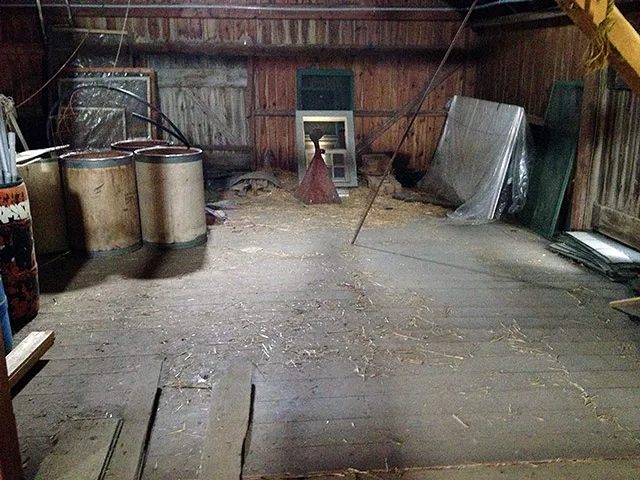The Fog of Harvest
Ten days ago harvest began. If you are at all like me, you want a controlled slide down this steeply descending slope. But there's no way because there's only me, there's distance, there's incessant rain, and there is the art of pulling the garlic at the right time for each individual variety -not over-mature, not under, and hopefully not rotten. A new field and a new environment have a lot to say.
The first to pull are the Turban and Asiatic strains. Skins more rotted than desirable thanks to the deluges we had mid-month. The silty soil here in Amagansett holds moisture quite well, easily 10 days from a good rain, and a considerable amount of rot had set in on the outer paper sheaths around each bulb. If anything I consider myself lucky that I was able to keep as many as I did.
On average the Turban strains netted a 13% loss from the quantity planted. The Asiatic strains averaged a 17% loss. While that number is pretty high, I'd say it should be even higher if I consider that I will not market 95% of the 'Asian Tempest' and 70% of 'Japanese'
because of poor size. After good early season performance, these strains suffered during the critical months of April and May due to imbalanced cultural conditions, cool and wet days, the consequent maggots (seed corn maggots, not onion, says Cornell), and then, finally two and a half months worth of rain in one week. I fully expect an almost total loss of marketable Creole and Purple Stripe strains as well when they are harvested later this week.
But there are also tough strains that held up to the less than ideal conditions; Rocambole 'Italian Purple,' Marbled Purple Stripe 'Siberian,' and what appears to be an exceptional late season performance by the Silverskin strain 'Nootka Rose.' The Elephant garlic appears in good shape and is ready for harvest. The Artichoke strains, which I harvested last Friday and Saturday, were in that peculiar harvest space typical of the new location. I think they could have sized up a little more, but clearly the skins were going to rot so they required pulling. Fortunately, most of those bulbs are marketable, from 1.25 -2 inches in diameter. That was not the case with last year's Artichoke that were uniformly undersized for the strain.
Artichoke 'Red Tochliavri' at harvest. The consistent tilth of this soil still amazes me.
The most peculiar performer is the Porcelain variety, having done so well until rather recently. These are usually the hardiest garlic plants, but the leaves have been dying down significantly faster for bulbs that should be harvested later than the Rocambole. A trip to the Beach Farm where I have twenty or so of the same strains of Porcelain growing showed a completely different story. Even though the Beach Farm is warmer on average, it appears that it is maturing its bulbs later than the garlic farm. The BF plants all looked healthy, showing significantly more green leaves at the same date. This is the opposite of what I would expect. Even the Purple Stripe "Chesnok Red' has done exceedingly well at the Beach Farm, whereas at the farm it is looking to be a total loss.
Purple Stripe 'Chesnok Red' at the Beach Farm.
A survey of the past month's weather data, from the nearest functioning weather stations shows that the Beach Farm received 8.93 inches of rain between June one and July two with an average monthly temperature of 70 degrees while the garlic farm received 7.6 (this station is Hampton Bays, but it is an indicative number) inches of rain with a monthly average temperature of 67 degrees at the nearby Amagansett station. The soil at the Beach Farm, despite an inch and a half more rain, is a considerably drier sandy loam. My guess is that the cooler temperatures and near constant moisture at the garlic farm has a negative effect on the more fussy garlic varieties.
So far I have pulled 2134 heads of garlic with nearly 4500 left to go (although that number is likely higher than yield). I expect decent returns on Italian Purple, Siberian, and Nootka. It is a dour task to pull garlic that is sickly or undersized, but that appears to be part of the harvest this year for Chesnok, Burgundy and Rosso di Sulmona as it was for Asian Tempest. I will try these varietal strains one more time, although in limited quantities given the loss of potential seed garlic.
This is the bunch and label rig. If the sun is shining, the harvested garlic needs to be in the shade.
Impromptu shed (with air) built out of my neighboring farmer's leftover wooden pallets. The garlic can be stacked in here over night until it can be shipped to the barn on following days. If it rains, there is a tarp on the roof.
Off to the barn. We can only carry so much in the van.

Two ferry trips, one from Northaven to Shelter Island and another from Shelter Island to Greenport. From there we drive to Southold where the barn resides.
Hudson Clove is sharing this barn with Browder's Birds and Invincible Summer Farms.
The barn is old and dusty with a few holes in the roof, as you would expect, but it only took an hour or so to get it prepared for the incoming garlic.
I moved those stacks of crates, snow fencing and the big slider door on the floor out of the main space.
I am told that I cannot go over there. Apparently it's above the young chicks. I can use anything up to the barrels, but no doors can be opened for ventilation. In this area I racked up the French Gray shallots.
After the cleanup.
We will have to get creative when the bulk of the garlic comes in as there is only enough air space for 2/3 of all the garlic.
Well that is all for now. I am actually pretty tired from all the driving and physical work and will be satisfied when the harvest is over. It feels good to see empty rows framed so nicely by the crabgrass and clover.















I can't explain why I so enjoy reading about your garlic farming. But I really do.
ReplyDeleteGlad to hear it. I often think I'm just complaining. Yet that's not how I mean it.
Delete